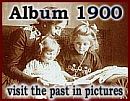
German Siblings (1870s)

Figure 1.--One of the problems in assessing 19th century trends pertaining to dresses is that many are unidentified. Of course the usually look like girls. Oftern they are, but this is not always the case as boys in many cases also had long hair. Thus we are left with the prioblem of attempting to determine the gender oif the children. This is often quite difficult. Both children here may be girls, but the child on the left might be a boy. Image courtesy of Albumn.1900.
|
One of the problems in assessing 19th century trends pertaining to dresses is that many available old photographs are are unidentified. Of course the children in dresses usually look like girls to our modern eyes. Oftern they are, but this is not always the case as boys in many cases also had long hair. Thus we are left with the prioblem of attempting to determine the gender oif the children. This is often quite difficult. Both children here may be girls, but the child on the left might be a boy. There is of courseno way of being sure in these old portraits. We can offer some preliminary thoughts. Our Album 1900 wenmaster thinks that the younger child has a boyish face. Assessing boyish or girlish faces is quite difficylt in young children. I just don't know about the younger child. The older child actually looks a little boyish.
The dress styles are quite similar, but I think that would be the case in these early images. Note the stand behind the children. That means a slow film. Thus this is probably a 1870s or even late 1860s portrait. In Britain plaid dresses are oiften a suggestion that the child is a boy. I'm less sure about Germany. The only other clue is the toy. Note the child has a pull toy rather than a doll. That seems to me to suggest a boy. Although a kitten is not the most boyish of pull toys. I think both boys and girls had pull toys, but think a pull toy here is a boyish hint, especially as the older child has a doll. There is also the law of averages to consider. The chances of having a boy or girl is roughkly 50:50, but the chances of having two girls is less. A German reader writes, "The smaller child's dress (child on the left) is plainer and the face looks somehow boyish. And yes, also the toy could indicate a boy. Did you notice that the toy is broken. Not a good studio prop!" The portrait was taken in Stettin. This city of Stettin in West Pomerania today belongs to Poland. I think the portrait was probably taken about 1870, but not much later. It could have been taken in the late 1860s." Note the stands in the background, a sign that slow film was still being used, showing that it was a early photograph.
HBC

|
Album1900

|
Navigate the Boys' Historical Clothing German pages:
[Return to the Main German dress chronology page]
[Return to the Main national dress page]
[German choirs]
[German youth organizations]
[German school uniforms]
[German royalty]
[German sailor suits]
[Lederhosen]
[Ethnic]
[Tights]
[Long stockings]
Navigate the Boys' Historical Clothing Web Site:
[Introduction]
[Activities]
[Biographies]
[Chronology]
[Clothing styles]
[Countries]
[Girls]
[Topics]
[Bibliographies]
[Contributions]
[FAQs]
[Glossaries]
[Satellite sites]
[Tools]
[Boys' Clothing Home]
Created: 9:33 PM 1/10/2005
Last updated: 3:14 AM 1/12/2005




